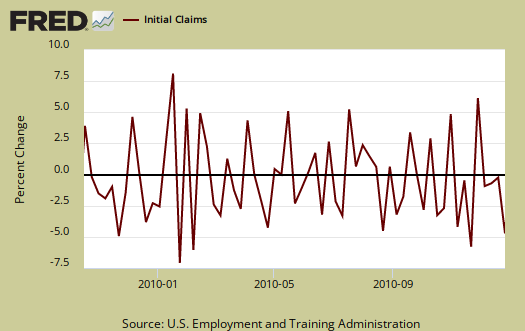Initial weekly unemployment claims dropped to 388,000 this week. This is the first time initial weekly unemployment claims have dropped below 400,000 for 2 years, 5 months or July 2008.

The question is how much the blizzards affected those filing. Weekly initial unemployment claims are seasonally adjusted, but it's unclear, when the entire country is shut down due to weather, plus the biggest holiday of the year, if those seasonally adjustments can possibly account enough for these events. Supposedly $1 billion was lost in retail sales due to weather, so one would assume this report is an anomaly for similar reasons.
From the jobless claims report:
In the week ending Dec. 25, the advance figure for seasonally adjusted initial claims was 388,000, a decrease of 34,000 from the previous week's revised figure of 422,000. The 4-week moving average was 414,000, a decrease of 12,500 from the previous week's revised average of 426,500.
Take that drop of 34,000 between weeks with a grain of salt. Every week the previously week's numbers are revised upward, with this week no exception, revised upward +2,000.
While one week does not a pattern make, this is still some great news. Finally breaking through that 400,000 threshold, I think anybody right now will take that, regardless if people were froze over and stuck in a snow drift, thus couldn't show up to the unemployment office. Still, the better number is the 4 week average, which is now at 414,000. That said, the 4 week average is also revised continually.
Below is the mathematical log of initial weekly unemployment claims, so one can get a better sense of the rise and fall of the numbers. A log helps remove some statistical noise, it's kind of an averaging.

Below is a graph of the percent change in initial weekly unemployment claims for the last year. Look at how the numbers change bobs around zero, up and down, like a yo-yo.

Below is the 4 week moving average, set to a logarithmic scale to remove even more statistical noise, for the last year. Here a trend that is certain would appear. It looks like we have a start, but keep your fingers crossed, wait and see. Again, we need this metric to stay below 400,000 and keep dropping. Numerous economists say the number is 375,000 to show job growth. We see a strong decline, but then again, hasn't everyone in America been fired by now?

Below is a 2 year view of the 4 week moving average, set to a log scale.

Less people collected the extended, or emergency unemployment insurance. Since we know people are dropping off of the rolls, this is the next wave in the long term unemployed.
States reported 3,711,288 persons claiming EUC (Emergency Unemployment Compensation) benefits for the week ending Dec. 11, a decrease of 77,741 from the prior week. There were 4,869,540 claimants in the comparable week in 2009. EUC weekly claims include first, second, third, and fourth tier activity.

I am really confused about
I am really confused about this.
The nonseasonally adjusted unemployment figure -- which I thought represented actual claims made by real unemployed people -- was 521,834.
I don't understand seasonally adjusted number is so much smaller, especially, as you note, there were numerous events in play to discourage people from filing. If anything, shouldn't the SA number been much higher than the NSA number?
Also -- why is everybody so happy? Isn't the 388,000 more or less a mirage that will disappear in a few weeks, when the holiday workers are dismissed?
can't find seasonal adjustments
I put a call into the DOL and if I ever get a real human, I'll post what else I can dig out. Also, each agency is different to me as well as very different attitudes towards public information and us regular folk questioning or examining these reports. Because I agree with you, it makes no sense during the holidays to have the adjustment be less due to seasonal hires should still be on the job...unless of course the assumption is they are fired right after Xmas.
So, how come during the week of Christmas, would the two be that much off?
I just don't know. This drives me nuts too, they should be publishing, in graphic detail, not only the seasonal adjustments, but their code, their algorithm and the assumptions.
The yearly adjustments on the unemployment report have only been off by a million jobs (not exact but it's a massive error!) which are adjusted after the fact.
While I agree one must make seasonal adjustments, I find it odious the algorithm, the software, the code and the assumptions, well, I cannot find them and when you're off by 200k in a week, I'd say we need some explanation.
I can tell you they assume there are significant seasonal layoffs during January, February, but this is December. I'm pretty sure they do not adjust for major unusual events, such as this week's blizzard.
Finally, initial unemployment claims is notorious as "happy talk", which I've railed against week after week.
The way the numbers are produced, each week appears to be a decline, when in fact it's poor data collection and reporting which causes it.
So, while this was a major event, you notice I make a lot of statements on the weather and believe this will be a data outliner, an anomaly too...
bottom line is we cannot even trust the monthly unemployment report so relying on the weeklies, because a very large time window and a time lag....is a huge error.
I call this the warm fuzzy but not really report. ;)
In other words, what I'm saying is I'll bet it jumps back up to 422k or so next week.